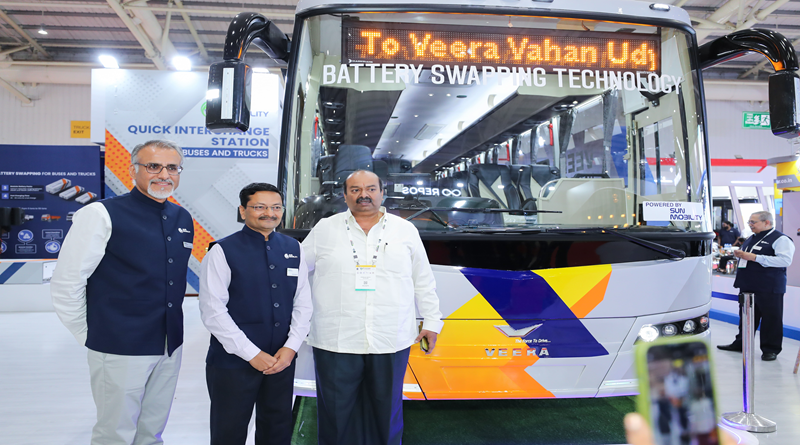Battery Swapping: A Game Changer for India’s Commercial Vehicles

Mumbai: India aspires to be energy-independent by 2047, the centenary year of its freedom, and in this pursuit, decarbonisation of the commercial vehicle segment, especially the heavy-duty buses and trucks will be imperative. Occupying less than 5% of the total vehicle fleet, heavy-duty buses and trucks account for about 50% of the transport-related emissions. Electric vehicles (EVs) have emerged as a leading technology in decarbonization, particularly in smaller segments such as two-wheelers and three-wheelers. However, the challenge of electrifying heavy commercial vehicles (HCVs) remains formidable due to their demanding energy requirements and operational complexities.
Globally, battery swapping has emerged as a promising solution for electrifying heavy electric vehicles (HEVs). Electric buses have seen significant traction in regions like China and Kenya. BasiGo in Kenya and Shenzen bus group in China procured buses without pre-fitted batteries. Further, in China, around 50% of the electric trucks sold in 2023 were swap-enabled. In Germany, the eHaul project is piloting HEVs up to 40 tonnes for battery swapping and these long-haul HEVs operate for more than 300 km a day. Ample and Yamato in Japan are also conducting dedicated swapping pilots for HEVs.
In India, the electrification of vehicles has been driven by a suite of policy support, fiscal subsidies, and the entry of new-age startups. However, the focus on HEV electrification has been limited. The recently launched PM E-bus Sewa and the State Transport Undertaking (STU) focused bus electrification through FAME subsidy focuses on the urban bus fleet, which is a minor share of the Indian bus market. The fleet operators in India face several challenges in transitioning to electric vehicles. Around 90% of India’s overall bus market is operated by fragmented private fleet owners, the majority of who have less than 5 buses and do not have access to subsidies and finance.
For commercial vehicles ranging from 3 tonnes to 55 tonnes, electrification is hindered owing to challenges like high upfront cost, longer charging times, battery obsolescence, and range anxiety. There is a limited and uneven distribution of charging and battery-swapping stations across India, particularly outside major urban areas. This limits the practicality of EVs for long-distance or intercity travel, where reliable access to charging is critical.

Battery Swapping is the Perfect Fit for India
To this end, battery swapping can be a game-changing opportunity for electrification for buses and trucks. It provides myriad benefits namely: zero downtime, increased productivity by ~30%, alleviated battery obsolescence concerns, reduced anxiety about battery performance and vehicle range, and improved affordability of HEVs.
First, battery swapping improves the affordability of heavy electric vehicles (HEVs) by significantly reducing the upfront cost. Since the battery constitutes almost 40% of an EV’s price, removing it from the purchase equation allows manufacturers to offer vehicles at a lower price point. This reduction in upfront cost can accelerate the adoption of EVs among fleet operators, making them a more viable alternative to traditional diesel-powered vehicles and their fixed-charging counterparts.
Second, battery swapping also alleviates the customers’ challenge of battery obsolescence by disassociating the battery from the vehicle. The customer need not worry about the high battery replacement cost over time, the battery performance, and the evolving battery technologies itself. This approach shifts the burden of battery maintenance and technology upgrades from the customer to the battery swap operator, offering peace of mind to fleet operators and allowing them to focus on their core operations.
Third, battery swapping offers a transformative solution to one of the most significant challenges in the adoption of electric vehicles: long charging times and the associated high-power demand from the grid. Instead of waiting for hours for a vehicle to recharge, drivers can quickly swap out depleted batteries for fully charged ones in a matter of minutes. This not only minimizes downtime but also reduces the strain on the power grid, as it eliminates the need for large-scale, high-demand charging infrastructure. Battery swapping also reduces the peak power requirement as charging in swap stations is conducted consistently.
Fourth, battery swapping directly addresses range anxiety and other operational challenges associated with EVs. The ability to quickly swap batteries eliminates concerns like longer waiting time and a dense battery swapping network will eliminate range anxiety. This will make electric vehicles more practical on high-demand routes like mofussil or intercity routes. High up-time demand operations like ports and cement industries where 20-22 hours of constant movement is required, swapping will emerge as a promising alternative to diesel-operated trucks without any productivity loss. This flexibility to swap the vehicle at ease is crucial for the heavy-duty segment, where reliability and uptime are paramount.
Fifth, once the battery is disassociated from the vehicle, the upfront cost is reduced, and the obsolescence related to technology and its performance is also mitigated as it is taken care of by the battery swap operator. The reduced upfront cost and removal of risks associated with the battery technology for the customer make it a lucrative option for financial institutions to fund at par with the ICE vehicles. In addition to the above benefits, SUN Mobility’s solution stands out with its modular and scalable battery packs, designed to cater to a wide range of commercial vehicles—from 7-meter buses to 13.5-meter buses and commercial vehicles ranging from 3 tonnes to 55
FOLLOW FOR MORE.







Say, you got a nice blog article. Really Cool.
Pretty nice post. I just stumbled upon your blog and wanted tosay that I’ve really enjoyed surfing around your blog posts.In any case I will be subscribing to your rss feed and I hope you write again verysoon!
Hi! I simply would love to offer a huge thumbs up for the wonderful information you have here on this article. I will be coming back to your blog for more soon.
Thanks for your marvelous posting! I truly enjoyed reading it, you happen to be a great author.I will make sure to bookmark your blog and definitely will come back someday.I want to encourage you to continue your great writing, have a nice morning!
Hi, every time i used to check blog posts here in the early hours in themorning, as i love to find out more and more.
I value the article post.Really thank you! Fantastic.
A round of applause for your blog.Really thank you! Want more.
Awesome blog article. Fantastic.
glyburide metformin metformin rx what is bad about metformin how does metformin work?
Appreciate you sharing, great article. Much obliged.
A big thank you for your blog post.Really thank you! Want more.
Asking questions are truly nice thing if you are not understanding something totally, butthis piece of writing presents fastidious understanding yet.Feel free to visit my blog post … eliminate yeast infection
mix hayedeh antenmusic .com/artist/hayedeh/
Very informative article post.Thanks Again. Will read on…
upcoming games. So tik tok followers no verification
Bardzo interesujący temat, dzięki za wysłanie wiadomości plastry na opryszczkę compeed plastry na opryszczkę compeed.
I cannot thank you enough for the article post.Much thanks again. Really Great.
Pretty section of content. I just stumbled upon your blog and in accession capital to assert that I get in fact enjoyed account your blog posts. Any way I will be subscribing to your feeds and even I achievement you access consistently quickly.
herbal equivalent to ivermectin ivermectin for heartworm
Im obliged for the blog article.Really thank you! Keep writing.
Major thanks for the article post. Fantastic.
Hey, thanks for the article post.Really thank you!
Major thanks for the blog article. Really Cool.
Thanks again for the article.Much thanks again. Awesome.
Great write-up, I am regular visitor of one’s blog, maintain up the excellent operate, and It’s going to be a regular visitor for a lengthy time.
Ja naprawdę doceniam twoją pracę, Świetny post test antygenowy wymazowy covid 19.
Everyone loves it when people get together and share opinions. Great blog, continue the good work!
Im thankful for the post.Really looking forward to read more. Really Great.
I cannot thank you enough for the blog.Really thank you! Awesome.
Awesome blog post.Much thanks again. Cool.
Thanks a lot for the post.Really looking forward to read more. Great.
There is definately a great deal to learn about this topic. I love all the points you’ve made.
Thanks for the article.Thanks Again. Really Cool.
Hi. Interesting post! I’m really appreciate it. It will be great if you’ll read my first article!)
Thanks for the blog.Much thanks again. Really Cool.
Really enjoyed this blog.Thanks Again. Really Cool.
Major thankies for the blog post. Great.
Thanks a lot for the blog article.Really looking forward to read more. Want more.
Very efficiently written story. It will be beneficial to everyone who utilizes it, as well as myself. Keep up the good work – looking forward to more posts.
Wow, great blog.Really looking forward to read more. Keep writing.
Great, thanks for sharing this article. Really Cool.
A round of applause for your article post.Much thanks again. Fantastic.
atorvastatin a blood thinner lipitor dangers
Wonderful forum posts, Thanks!essay writing service best thesis statement for research papers writer dissertation
I like what you guys are up too. Such clever work and reporting!Keep up the good works guys I’ve incorporated you guys to blogroll.My blog post – Dwain
Appreciate you sharing, great post.Really looking forward to read more. Keep writing.
Hey, thanks for the article.Really thank you! Will read on…
Looking forward to reading more. Great article.Thanks Again. Really Great.
I value the post.Thanks Again. Cool.
Fantastic article.
is hydroxychloroquine an immunosuppressant plaquenil medicine
Heya i’m for the primary time here. I found this board and I find It truly helpful & it helped me out a lot. I am hoping to present something back and help others such as you helped me.
Thanks again for the blog post.Really thank you! Awesome.
Nice post. I was checking constantly this blog and I amimpressed! Extremely helpful information specially the last part 🙂 I care for such infomuch. I was seeking this particular information for a verylong time. Thank you and best of luck.
Hello, recognition you for word! I repost in Facebook
I appreciate you sharing this article.Really looking forward to read more. Really Cool.
Major thanks for the article post. Really Cool.
I need to to thank you for this good read!! I absolutely loved every little bit of it. I’ve got you book-marked to look at new things you post…
Omulhl – acquisto vardenafil online Zldabz nalkky
I really liked your blog article.Really thank you! Great.
What a material of un-ambiguity and preserveness of precious knowledge on the topicof unexpected emotions.
I don?t even know how I ended up here, but I thought this post was good. I don’t know who you are but definitely you’re going to a famous blogger if you aren’t already 😉 Cheers!
I’ll immediately take hold of your rss as I can’tin finding your email subscription link or newsletter service.Do you have any? Please let me realize in order that I could subscribe.Thanks.
I really liked your blog.Thanks Again. Awesome.
wow, awesome blog article.Thanks Again.
I do not even know the way I stopped up right here, however I thought this put up was good. I don’t know who you might be but definitely you’re going to a well-known blogger if you happen to are not already 😉 Cheers!
Many thanks! I value it!how to write a good essay how to write essays in college custom writing services reviews
I am not positive where you are getting your info, however good topic. I must spend some time learning more or understanding more. Thanks for excellent information I used to be in search of this info for my mission.
Thanks so much for the blog article.Much thanks again. Really Great.Loading…
felodipine vs amlodipine what class is norvasc
Real informative and fantastic bodily structure of articles, now that’s usergenial (:.Here is my blog sleep problem
alternatives to tamoxifen nolvadex – tamoxifen
Hello my loved one! I wish to say that this article is awesome, great written and come with approximately all vital infos. I’d like to look extra posts like this.
Thank you, I’ve just been looking for info approximately thistopic natural treatment for eczema a while andyours is the greatest I have came upon till now. But, what about the conclusion? Are you sure concerning the supply?
Really appreciate you sharing this blog. Really Great.
I really like and appreciate your blog. Awesome.
No matter if some one searches for his required thing, thus he/she needs to beavailable that in detail, therefore that thing is maintained over here.
Thanks-a-mundo for the blog.Really looking forward to read more.
Very neat blog article.Really looking forward to read more. Want more.
I truly appreciate this post.Really looking forward to read more. Keep writing.
Thank you for Article your articles very great write.You can find Good Store here ดูหนังออนไลน์ hd
Thimbleberry Pi Internet Cómo convertir un Thimbleberry Pi en un altavoz de Internet
A big thank you for your blog. Want more.
I value the article.Much thanks again. Great.
WOW just what I was searching for. Came here by searching for Bet365
how fast does cbd oil work for anxiety for dogs
I cannot thank you enough for the blog.Thanks Again. Will read on…
Really informative blog article.Much thanks again. Keep writing.
Enjoyed every bit of your blog post.Thanks Again.
interactions for ivermectin ivermectina walmart
I think this is a real great article post.Really looking forward to read more.
Fantastic article post.Really thank you! Will read on…
wow, awesome blog.Really looking forward to read more. Great.
Thanks a lot for the article.Really thank you! Awesome.
Thanks for the blog.Really thank you! Awesome.
I loved your blog.Thanks Again. Really Great.
Very informative post.Really thank you! Fantastic.
Im thankful for the blog. Awesome.
I value the post. Keep writing.
I cannot thank you enough for the blog article.Really looking forward to read more. Keep writing.
I follow you with interest. very nice blog.
Normally I do not read article on blogs, but I would like to say that this write-up very pressured me to try and do so! Your writing style has been surprised me. Thanks, quite great article.
This is one awesome blog post. Great.
I get pleasure from, cause I discovered exactly what I was looking for.You have ended my four day long hunt! God Bless you man. Havea great day. Bye
Thank you for your post.Really thank you! Keep writing.
Very good blog article.Thanks Again. Cool.
Say, you got a nice post. Awesome.
สล็อตออนไลน์เกมคาสิโนที่ได้รับความนิยมชั่วกัลปวสาน เล่นง่าย แจ็คพอตแตกไวจำเป็นที่จะต้องที่ UFABET จ่ายจริง จ่ายเต็ม มีเกมให้เลือกหลายชิ้นทั้งพนันบอล บาคาร่า ยิงปลา มาเว็บไซต์นี้เว็บไซต์เดียวโคตรคุ้ม สร้างรายได้ง่ายๆจบที่เว็บไซต์ UFABET ได้เลยนะครับ
Wow, great blog post.Thanks Again. Will read on…
Great article post.Thanks Again. Awesome.
kamagra pills: top erectile dysfunction pills erectile dysfunction pills
Amazing! Its genuinely amazing post, I have got much clear idea concerning fromthis post.
Wow that was strange. I just wrote an very long comment but after I clicked submit my comment didn’t show up. Grrrr… well I’m not writing all that over again. Anyway, just wanted to say great blog!
This is a good tip especially to those new to the blogosphere. Brief but very accurate information… Thank you for sharing this one. A must read post!
п»їivermectin pills stromectol drg – ivermectin generic
Thanks, I value this.online essay writershelp writing paper
A big thank you for your article post.Really looking forward to read more. Keep writing.
La mejor elección libre para la expectativa 2021
I appreciate you sharing this blog post.Thanks Again. Will read on…
I appreciate you sharing this article.Really looking forward to read more. Will read on…
Slot เกมสล็อตเป็นเกมที่สนุกตื่นเต้นและเกมสล็อตออนไลน์ก็มีการเล่นที่สนุกไม่แพ้กับการเล่นสล็อตจากตู้สล็อตทั่วไปเลย.อิอิ
pharmacy technician salaries in canada canadian certified pharmacy
Very informative post. Awesome.
Im grateful for the post.Thanks Again. Want more.
find my credit score check your credit rating free credit report no credit card
магазин аккаунтов покупка аккаунтов
безопасная сделка аккаунтов продать аккаунт
аккаунты с балансом аккаунты с балансом
безопасная сделка аккаунтов https://kupit-akkaunt-top.ru/
Hmm is anyone else having problems with the images on this blog loading?I’m trying to determine if its a problem on my end or if it’s the blog.Any responses would be greatly appreciated.Also visit my blog post … make healthy eating
Buy accounts Account market
Account Trading Service Account Selling Platform
wow, awesome article post.Thanks Again. Want more.
Wow, great blog. Awesome.
Thanks for the blog post.Really looking forward to read more. Will read on…
A big thank you for your article.Much thanks again. Want more.
I think this is a real great article post.Really looking forward to read more.
I enjoy what you guys are up too. This sort of clever work and coverage!Keep up the awesome works guys I’ve included you guys to our blogroll.
Awesome article post.
Thanks a lot for the blog post.Thanks Again.
Very great post. I just stumbled upon your blog and wished to mention that I’vereally enjoyed browsing your blog posts. In any case I will be subscribing in your feed and I hope you write again very soon!
Currently it seems like Drupal is the preferred blogging platform available right now. (from what I’ve read) Is that what you’re using on your blog?
купить аккаунт akkaunty-na-prodazhu.pro
Hey, thanks for the blog article. Cool.
покупка аккаунтов https://akkaunt-magazin.online/
I am so grateful for your blog post.Thanks Again. Cool.
маркетплейс аккаунтов https://akkaunty-optom.live/
маркетплейс аккаунтов online-akkaunty-magazin.xyz
маркетплейс аккаунтов соцсетей https://akkaunty-dlya-prodazhi.pro/
покупка аккаунтов купить аккаунт
facebook account buy buy aged facebook ads accounts
facebook ads account buy https://buy-ad-accounts.click
buy facebook account https://buy-ad-account.top
Appreciate you sharing, great blog.Really thank you!
Looking forward to reading more. Great post. Want more.
I really liked your post.Really looking forward to read more. Want more.
Great, thanks for sharing this blog article.Really looking forward to read more. Will read on…
Enjoyed every bit of your blog article.
Really informative blog post.Thanks Again. Much obliged.
This is one awesome article post.Really thank you! Keep writing.
I cannot thank you enough for the blog.Much thanks again. Want more.
Howdy! I could have sworn I’ve been to this blog before but after reading through some of the post I realizedit’s new to me. Anyhow, I’m definitely delighted I found it and I’ll be book-marking and checking backfrequently!
Awesome post. Keep writing.
Fantastic post.Really looking forward to read more. Keep writing.
Great, thanks for sharing this article post.Really thank you! Fantastic.
I really enjoy the blog.Really looking forward to read more. Awesome.
I think this is a real great post.Thanks Again. Fantastic.
Very neat article post.Much thanks again. Cool.
Major thankies for the post.Really looking forward to read more. Awesome.
Thanks for the blog post.Really looking forward to read more. Will read on…
Great, thanks for sharing this post.Thanks Again. Fantastic.
Really appreciate you sharing this article post. Great.
Enjoyed every bit of your article post.Really looking forward to read more. Fantastic.
Major thankies for the post. Keep writing.
I really like and appreciate your blog article.Really thank you! Really Great.
I really like and appreciate your article post. Keep writing.
I appreciate you sharing this blog article.Really thank you! Awesome.
I loved your post.Really looking forward to read more. Really Cool.
I really like and appreciate your article post.Thanks Again. Want more.
I really liked your blog post.Thanks Again. Really Great.
Appreciate you sharing, great blog post.Much thanks again. Cool.
Muchos Gracias for your article post.Really thank you! Want more.
Very informative post.Thanks Again. Really Cool.
I really enjoy the article.Really thank you!
Muchos Gracias for your blog post.Thanks Again. Really Cool.
I really like and appreciate your article post. Really Cool.